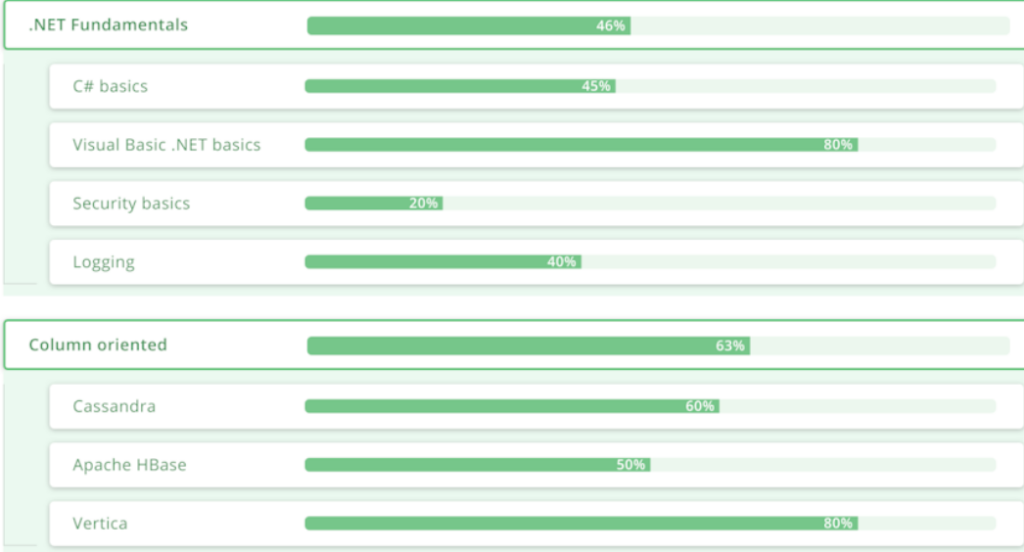Skills vs competencies: What’s the difference?

When browsing job descriptions, required skills, and preferred core competencies, you might ask yourself whether skills and competencies are different things. In fact, you might already be using the two terms interchangeably.
Well, HR professionals differentiate between them because understanding the differences can change the way an organization creates job descriptions, plans its own development, or creates a competitive strategy for people improvement.
This article will explore:
- Competencies vs skills
- Why it’s key to know the difference
- How proper software can help you in measuring performance
Skills
In essence, skills are individual and transferable abilities that help you to perform tasks, while competencies combine skills, behaviors, habits, knowledge, and experience to fulfill a certain role at an organization. Let’s delve deeper into what constitutes a skill.
Skills are specific learned abilities that you need in order to perform a task. Some of these may include coding in C#, writing a formal email, or invoicing clients. All of those can be learned in days, months or years.
On top of that, they are transferable. If you can code in C# and change companies, chances are you will know what to do in your new role. If you’ve been taking care of finances and know you have to perform effectively as a person who invoices clients, you’ll most likely do just fine.

Moreover, skills tend to be classified as hard skills and soft skills. Technical skills are often thought of as hard skills. These are always related to a specific tool and frequently in a narrow field. They also have to be learned and practised.
On the other hand, soft skills (human skills) might include conflict resolution, time management, active listening, or holding a business conversation. These won’t differ heavily depending on the industry or company, as they are universally useful. A plumber does not need an unrelated hard skill like data analytics, but knowing how to manage their own time or listen to their client’s needs would be very useful.
Soft skills facilitate work between people, and a lack of these can cause serious issues. While a person may think that they can do their job well, in every company there will be some type of cross-interaction between people, teams, or departments.
Competencies
Competencies differ a bit from skills, even though in general language usage you might interchange them. Competencies involve abilities, knowledge, experience, and behavior that lead to being successful in a specific role. This shows that competencies are much less transferable than skills. That’s not to say they will completely differ from business to business but rather they may involve different key elements. A competency of strategic planning, for instance, will certainly not overlap completely between the two entities.

Sticking to the example of strategic planning, it entails multiple skills, abilities, and specific knowledge to put into practice. There may even be a separate role in the company with the job title of Strategic Planner. You might need a specific skill (technical skill) in using company software, certain skills pertaining to planning itself, and knowledge about the company’s history, current situation, and external factors.
Project management or talent management could also be considered competencies if thought of as a function of skills, knowledge, and experience specific to a company.
Why is it important to distinguish between skills and competencies?
As a manager, you need to be able to tell the difference in order to be able to look at your existing workforce or a potential job candidate and be certain whether they meet the job requirements. Have they got a specific competency you’re looking for? Do they possess specific skills that are requisite? Did you create detailed job descriptions knowing what the differences are?
This is also where talent management comes in. As a company, you should have proper competency models or a competency framework to have a clear understanding of what’s needed. You also want to work out the skills needed for a specific job.
Due to the nature of both, skills are much easier to develop. They are self-contained pieces that can be trained during workshops or even on your own. Learning pronouns in French might take an hour while English tenses, a full weekend. Still, they are finite, easily definable and measurable.

On the other hand, competencies involve a set of skills and behaviors that cannot be learned overnight. These take significantly longer to absorb and put into practice. A competency system might be useful at outlining competency gaps or a core competency someone lacks, but they are much tougher to implement and are less agile, compared to skill-based talent strategies.
Using software to manage skills
Writing down the whole competency framework in your notebook and listing existing employees in your spreadsheet may have been the way to go a few decades back. Nowadays, we have access to sophisticated software solutions that can help you build a complex model.
While competencies have their place, they are much more difficult to manage, as mentioned earlier in the piece. That’s why a competency model will have to step down in favor of a skills-oriented approach that is more agile, flexible, and helps measure development.
DevSkiller TalentBoost is an invaluable tool for many learning teams who want to start applying a skills-based approach to their talent management
TalentBoost uses skill maps to create visual representations of skills. Crucially, skill maps aggregate skills based on their thematic grouping. There are multiple areas of skills such as Cloud, IT Security, or Software Architecture. Within each, you will find a few dozen or even hundreds of individual skills that pertain to that specific category. Thanks to this approach, you can see a tree of relations within a topic such as HTML or React Testing.
However, the real highlight is using skill sets to describe individual employees. A software engineer does not have to know everything in the Software Development area. On the contrary, they need just a portion of that and a few skills from other areas. After all, you want your engineer to also have some architecture-related skills and be experienced in Сloud.

When you start aggregating skills not by theme but by role, you get a skill set. TalentBoost allows you to create a role of, say, Regular Backend Developer, wherein you can create a full skillset showing what such a person needs to complete projects. This could be a mixture of skills from areas such as Software Development, Cloud, and Soft Skills, albeit to different degrees.
This helps your workforce planning efforts as the job description that you are going to write is going to highlight exactly what’s needed. On the other side, there is a potential employee who’s in the midst of a job search process and will be fully informed of what is expected of them.
Last but not least, you can plan out a learning path for your employees that takes any not-yet-possessed skills into account and creates a career plan for learning these. Consequently, both the manager and the employee know what is required to proceed to the next level and get a promotion. It’s a measurable process that’s oriented on measured skill qualifications rather than personal opinions.
Concluding thoughts
If you’re looking to plan out a skills-based approach in your company, you will need to be meticulous in your efforts. It’s a process that takes quite some time and effort. However, implementing a tool like TalentBoost can make the task infinitely easier.
If you would like to learn more about TalentBoost or discuss your skill-based approach, then book a free call with one of our product experts.
Share post